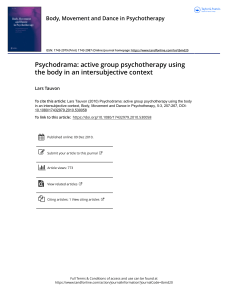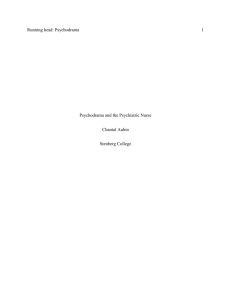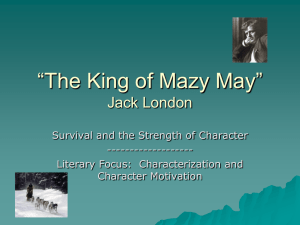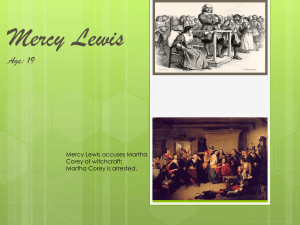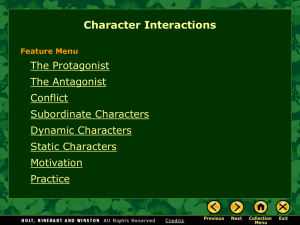Psychodrama
advertisement
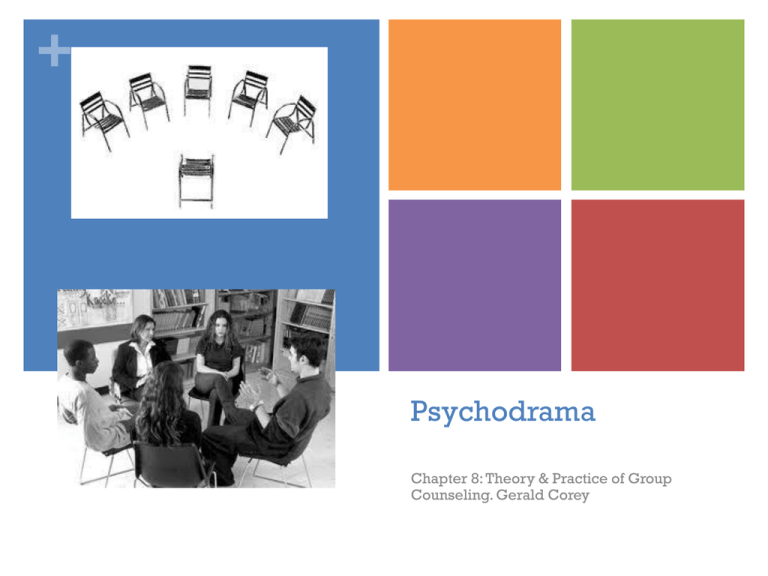
+ Psychodrama Chapter 8: Theory & Practice of Group Counseling. Gerald Corey + Introduction to Psychodrama Psychodrama is an action technique in group therapy which allows clients to explore their problems through role playing and other dramatic devices to gain behavioral skills and insights. (Corey, 2008, p. 190). + Creation of Psychodrama Created in the 1930’s by J.L. Moreno and Further Developed by his wife Ezra Toméan Moreno and other followers. Role playing is an example of a psycho dramatic method. The key feature of psychodrama is that it provides an opportunity to try new solutions and reactions to a given scenario. It is practice for real life situations and to try new roles. This method helps promote creativity, problem solving, communication, and selfawareness. (Corey, 2008, p. 191). + Key Concepts and Perspectives Creativity: Moreno believed that an essential feature of therapy is to facilitate the clients creativity in exploring themselves and discovering new coping skills for life. Spontaneity: The best way to encourage creativity is through spontaneous exploratory activities. Moreno sought to implement activities which fostered the courage to improvise. Working in the present moment: An important element of psycho drama is to reinvent previously experienced events and learn new reactions through role playing. Encounter: Group members must connect with one another in a meaningful and genuine manner. Tele: Moreno referred to this as “the cement which holds groups together.” Similar to the concept of rapport. (Corey, 2008, p.191193). + Key Concepts and Perspectives continued Surplus Reality: Re-enactments of the clients psychological world without the constraints of reality. Catharsis and Insight: Catharsis is the release of emotions during psychodrama. Insights are the cognitive shifts in awareness that are produced by the catharsis. Reality Testing: The testing of behaviors in scenarios that would potentially not be socially acceptable in a safe environment. Role Theory: Moreno’s idea that we are all actors engaging in improvisation in daily life on the “stage of life.” (Corey, 2008, p.195-196). + Role of the Group Leader •Also referred to as the psychodrama Director, the group leader is the producer, the facilitator and catalyst, observer and analyzer. •The Director’s primary responsibility is to help engage the group in improvisation and creating an environment where spontaneity is encouraged. (Corey, 2008, p. 197). + Necessary Players in Psychodrama The Protagonist: The focus of the psychdramatic enactment. This individual presents the problem to be explored. Group members should feel comfortable to decline the role of protagonist or volunteer should they desire to. The Auxiliary Egos: The supporting roles, usually portraying significant people in the protagonists life. The Audience: The audience is the remainder of the group who observe the enactment. The Stage: Area where the enactment takes place. (Corey, 2008, p. 198-199). + Psychodrama continued Classic psychodrama involves a series of phases termed warm-up, protagonist-centered work, and sharing. + Phase 1: The Warm-Up Initial activities to build group trust and coherence. For example the group leader may introduce the purpose of the role-plays and then interview each group member about potential scenarios that they may wish to explore through a dramatic experience. The goal is to foster spontaneity and a willingness to try new behaviors and a sense of playfulness. (Corey, 2008, p. 200). + Phase 2: Action Phase •The Action phase is engaging the the role-play scenario. •The goal is to bring awareness to feelings or attitudes the scenario elicits that perhaps the protagonist was not previously aware of. •Important to avoid commentaries and instead have the protagonist engage in alternative responses to a given scenario. (Corey, 2008, p. 201-202). Phase 3: Sharing + and Discussing •Group members should discuss how the enactment affected them and avoid analyzing the protagonist or offering advice. •Sharing with the group leads to bonding and a sense that one is “not alone” •It takes courage to share so the protagonist deserves to be honored. (Corey, 2008, p.203-205). + Therapeutic Techniques and Procedures Self-presentation: The protagonist introduces the situation to be enacted. Role Reversal: The protagonist plays the role of someone other than themselves in their chosen scenario. Considered one of the most powerful tools in psychodrama. Double: An auxiliary character plays the part of the protagonists inner self. Soliloquy: Protagonist imagines themselves in a place where they are free to vocalize their thoughts. The Empty Chair: Jacob Moreno originated this technique which was later adopted by the Gestalt movement. Mirror Technique: Aimed at fostering self-reflection. Another member mirrors the actions and gestures of the protagonist. Future Projection: Enactments designed to help group members work out future scenarios about which they have concerns. (Corey, 2008, p.206-210). + Therapeutic Techniques and Procedures Continued The Magic Shop: A warm-up technique in which the participant imagines themselves in a shop full of jars which contain different personality traits. The participant then expresses these qualities and then exchange them for another. Replay: Trying a scenario again. Role Training: A new reaction being tested by a protagonist in order to experience how it feels to act out a new behavior. (Corey, 2008, p. 211). + Psychodrama and Group Work in Schools •Role-playing can be useful in schools and help students to gain perspective and a way to integrate emotions and creativity. •Some techniques in classical psychodrama are too intense for children, adolescents, or a school setting. •Role-reversal can help build empathy and is an appropriate technique to employ with this age group. (Corey, 2008, p.212). + Psychodrama and Multicultural Populations If English is not a participants native language the participant is encouraged to speak in their native language as this allows them to more fully experience their emotions. Afterwards the participant can summarize some of their experience for the rest of the group. If a group member is not comfortable with self disclosure many of the techniques in psychodrama would not be appropriate but there is much to be gained as an audience member observing the enactments of others. (Corey, 2008, p. 213). + Evaluations of Psychodrama + Evaluations of Psychodrama Contributions and Strengths: Action oriented approaches allows participants to experience a given scenario in a mode other than simply talking about it. Allows participants to see and discover alternate ways of dealing with those around them. Integration with other Theories: Many of these techniques can be employed and provide rich material. For example Gestalt therapy successfully incorporates the empty chair technique. Limitations: Group leaders must take caution when dealing with a participant who has significant disturbances and must consider the safety of other group members. Has limited value for participants who are very uncomfortable with sharing and acting out scenarios. These techniques may not be appropriate for those with social anxieties or reserved personalities. Group leaders should have received training as a safeguard for practicing these techniques. (Corey, 2008, p. 214-217). + References Corey, G.(2008). Theory and practice of group counseling (8th ed.). Belmont, CA: Brooks/Cole.



